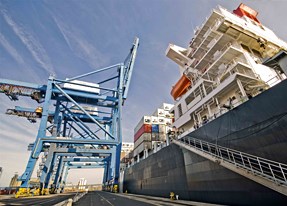 Background and Current System Issues: Traditionally, diesel generators have provided the power for RTG cranes. Diesel generators offer flexible operation, but have several major issues: low power conversion efficiency, high power consumption, high cost, as well as severe pollution, noise and vibration.
Background and Current System Issues: Traditionally, diesel generators have provided the power for RTG cranes. Diesel generators offer flexible operation, but have several major issues: low power conversion efficiency, high power consumption, high cost, as well as severe pollution, noise and vibration.
With the trend toward environmental protection, energy saving, and CO2 emission reduction and faced with high oil prices, many RTG crane users have started to look for more power efficient solutions or to modify their current RTG crane systems. They tend to replace diesel power with electric power to address the issues of current RTG crane systems; however, without an active front end, the new electrical RTG crane systems still have several problems:
Regenerative Power Wasted: During RTG crane operation heat is constantly generated and dissipated through brake modules. Besides energy wasted, users have to spend extra for the maintenance of brake modules.
Harmonic Pollution: Other equipment, such as inverters, in the RTG crane system may produce nonlinear loads, causing severe harmonic pollution. The system voltage is unstable and can affect normal operation.
Low Power Efficiency (Power Factor or PF): The RTG crane work load constantly changes which may cause low PF, and the user may be fined by the local electric company.
Delta's Solution: Delta Industrial Automation has introduced Delta's AFE2000 Series active front end to RTG crane systems, which has helped to improve the PF while collecting regenerative power. In the original system, power is provided to the DC BUS through a power factor correction rectifier. Delta's solution adds an AFE2000 Series to the original system. The AFE2000 Series conducts a self-diagnosis every time the system starts operation. If the diagnosis result is normal, it automatically transfers power to the DC BUS via the AFE2000 Series instead of the power factor correction rectifier.
During RTG crane system operation, the AFE2000 Series will detect and transform the heat generated into power, conduct reactive power compensation and then return the regenerated power to the grid system for reuse. This is how it replaces a brake resistor. When the AFE2000 needs troubleshooting or maintenance, it sends commands for the system to operate in the original way with power provided to the DC BUS through the power factor correction rectifier.